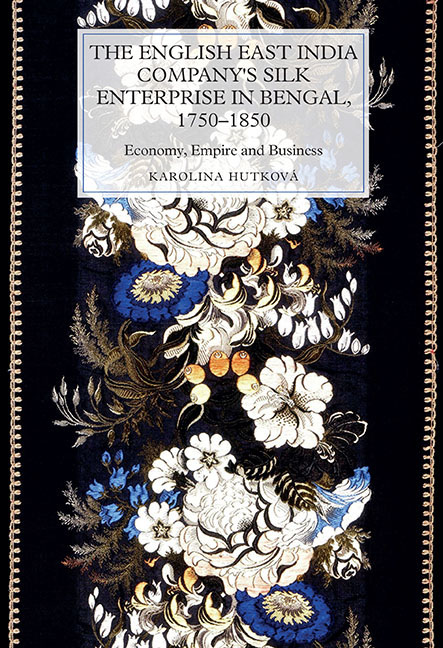Book contents
- Frontmatter
- Contents
- List of Illustrations
- Acknowledgements
- List of Abbreviations
- Measures and Currencies
- Introduction: Companies, Political Economy and the Great Divergenc
- Chapter 1 The Early Modern Silk Industry, Trade and Mercantilism
- Chapter 2 Empire, the English East India Company, and Bengal Raw Silk
- Chapter 3 Bengal, Piedmont and the English East India Company
- Chapter 4 The Bengal Silk Industry and the English East India Company
- Chapter 5 Filatures and Performance in the Bengal Silk Industry
- Chapter 6 The Bengal Silk Industry and British Laissez-Faire Policies
- Chapter 7 Bengal Raw Silk and British Demand in the Nineteenth Century
- Conclusion
- Appendix A Description of the Piedmontese Reeling Machine by Dionysius Lardner
- Appendix B Average Prices of Bengal Raw Silk on the British Market According to the Type of the Silk, 1796–1856
- Appendix C Return on Investment Analysis
- Appendix D Comparison of Manufacturing Costs at the EEIC's Experimental Filature and Common Filature in its Vicinity, 1832
- Appendix E Mechanisation of Silk Throwing and Weaving in England and Scotland, 1856
- Appendix F Types of Silkworm Reared in Bengal Silk Districts, 1818
- Appendix G Glossary
- Bibliography
- Index
- WORLDS OF THE EAST INDIA COMPANY
Chapter 4 - The Bengal Silk Industry and the English East India Company
Published online by Cambridge University Press: 31 August 2019
- Frontmatter
- Contents
- List of Illustrations
- Acknowledgements
- List of Abbreviations
- Measures and Currencies
- Introduction: Companies, Political Economy and the Great Divergenc
- Chapter 1 The Early Modern Silk Industry, Trade and Mercantilism
- Chapter 2 Empire, the English East India Company, and Bengal Raw Silk
- Chapter 3 Bengal, Piedmont and the English East India Company
- Chapter 4 The Bengal Silk Industry and the English East India Company
- Chapter 5 Filatures and Performance in the Bengal Silk Industry
- Chapter 6 The Bengal Silk Industry and British Laissez-Faire Policies
- Chapter 7 Bengal Raw Silk and British Demand in the Nineteenth Century
- Conclusion
- Appendix A Description of the Piedmontese Reeling Machine by Dionysius Lardner
- Appendix B Average Prices of Bengal Raw Silk on the British Market According to the Type of the Silk, 1796–1856
- Appendix C Return on Investment Analysis
- Appendix D Comparison of Manufacturing Costs at the EEIC's Experimental Filature and Common Filature in its Vicinity, 1832
- Appendix E Mechanisation of Silk Throwing and Weaving in England and Scotland, 1856
- Appendix F Types of Silkworm Reared in Bengal Silk Districts, 1818
- Appendix G Glossary
- Bibliography
- Index
- WORLDS OF THE EAST INDIA COMPANY
Summary
The Company's commercial interest in Bengal raw silk dated back to the breakdown of the negotiations between Sir Thomas Roe and the Sophy of Persia in 1617, which aimed to secure for the EEIC the monopoly in trading Persian silk. Trade in Bengal silk was promoted from 1675. As the legislation of 1699, 1702 and 1720 curtailed the Company's opportunities for legally importing finished silk fabrics into Britain, it turned its attention to Bengal raw silk. However, the reputation of Bengal raw silk among European silk manufacturers and weavers was one of low quality. The main complaint was that it was coarse and unequal in skeins. Its quality did not allow for immediate use in weaving, and the fact that Bengal raw silk required reworking prior to utilisation diminished demand. Problems with the quality of raw silk were so serious that at times they threatened to halt trade altogether. Aware of the issues, the Company decided to adopt the Piedmontese system of silk reeling in Bengal. The Piedmontese technologies relied on centralisation of silk reeling and made the Company's direct involvement in production essential.
This explains why the EEIC set up what I call ‘the Bengal Silk Enterprise’. This label aims to emphasize the fact that it was the only instance in which the Company expanded its activities into manufacturing. This chapter first examines the transfer of Piedmontese technologies to Bengal and second, it focuses on the changes that the adoption of the new technologies had on sericulture. It then considers the effects that adoption of the Piedmontese silk technologies had on the Company's trade in Bengal raw silk. Finally, the chapter examines the system of quality control.
Transfer of the Piedmontese Silk-Reeling Technology to Bengal
Aware of the inadequate quality of Bengal raw silk the Court of Directors – the highest managerial body of the Company – decided in 1769 to transfer the Piedmontese method of reeling to Bengal. This was not the first time the Company had attempted to make changes to the reeling method: experiments were first carried out in the 1750s but did not succeed. In what was then a putting-out system, the reelers refused to implement new practices, fearing that these would reduce the speed of reeling and therefore the quantities of reeled yarn produced.
- Type
- Chapter
- Information
- The English East India Company's Silk Enterprise in Bengal, 1750–1850Economy, Empire and Business, pp. 91 - 118Publisher: Boydell & BrewerPrint publication year: 2019

